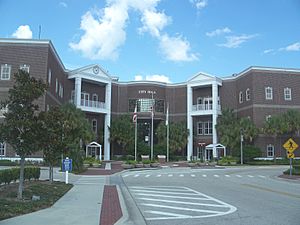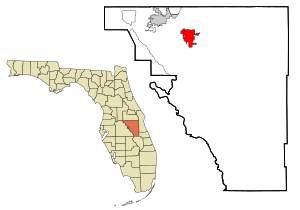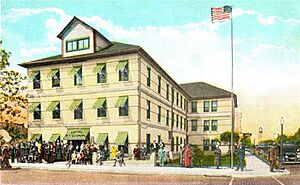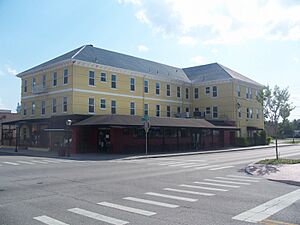St. Cloud, Florida facts for kids
Quick facts for kids
St. Cloud, Florida
|
||
|---|---|---|

St. Cloud City Hall
|
||
|
||
| Nickname(s):
The Friendly Soldier City
|
||
| Motto(s):
"Your Centerplace for Life"
|
||

Location in Osceola County and the state of Florida
|
||
| Country | United States | |
| State | Florida | |
| County | Osceola | |
| Founded | April 16, 1909 | |
| Incorporated | January 3, 1911 | |
| Government | ||
| • Type | Council–Manager | |
| Area | ||
| • Total | 25.53 sq mi (66.11 km2) | |
| • Land | 25.49 sq mi (66.02 km2) | |
| • Water | 0.04 sq mi (0.09 km2) 0.061% | |
| Elevation | 69 ft (21 m) | |
| Population
(2020)
|
||
| • Total | 58,964 | |
| • Density | 2,313.22/sq mi (893.13/km2) | |
| Time zone | UTC-5 (EST) | |
| • Summer (DST) | UTC-4 (EDT) | |
| ZIP codes |
34769, 34771-34773
|
|
| Area code(s) | 321, 407, 689 | |
| FIPS code | 12-62625 | |
| GNIS feature ID | 2405392 | |
St. Cloud is a city in northern Osceola County, Florida, United States. It is located on the southern shore of East Lake Tohopekaliga in Central Florida. St. Cloud is about 26 miles (42 km) southeast of Orlando. In 2010, the city had a population of 35,183. By 2020, the population grew to 58,964 people. The city is part of the larger Orlando–Kissimmee–Sanford metropolitan area.
St. Cloud was first created as a place for Civil War veterans from the Union army to retire. Because of this, it earned the nickname "The Friendly Soldier City."
Contents
History of St. Cloud
In the 1870s, a man named Hamilton Disston from Philadelphia became interested in developing the Florida region. He was on fishing trips with Henry Shelton Sanford, who founded the city of Sanford. Disston made a deal with the Florida Internal Improvement Fund. He paid $1 million to help the state pay off its debts from the Civil War and the time after it, known as the Reconstruction. In return, Disston received half of the land he drained from the state's swamps.
He dug canals and, between 1886 and 1887, started the St. Cloud sugarcane plantation. It was named after St. Cloud, Minnesota. However, many people who have lived in the area for a long time believe the town was named after Saint-Cloud, France.
Disston opened the Sugar Belt Railway in 1888. This railway connected to the South Florida Railroad. It helped carry his sugarcane products to market. But a financial crisis in 1893, called the Panic of 1893, caused land values to drop. Then, the Great Freeze of 1894–1895 destroyed the plantation. Disston went back to Philadelphia and passed away in 1896. The Sugar Belt Railway later joined with the South Florida Railroad.
An attempt to grow rice in the area did not work out. For several years, the land was not used. Then, in 1909, the Seminole Land & Investment Company bought 35,000 acres (14,000 ha). They planned to create a colony for veterans of the Grand Army of the Republic. St. Cloud was chosen because of its "health, climate and productiveness of soil." William G. King, a real estate manager, was given the job to "plan, locate and develop a town." He was the first person to settle there permanently in 1909.
On April 16, 1909, the Kissimmee Valley Gazette newspaper announced the "New Town of St. Cloud." It was called a "Soldiers Colony" near Kissimmee. The newspaper said the Seminole Land and Investment Company's purchase was "one of the most important real estate deals ever made in the State of Florida." It was reported that the company searched all over Florida for the best place for a veterans' colony. They especially looked for a place good for "health, climate, and productiveness of the soil." Many streets are thought to be named after states where Civil War veterans served. However, the street names were actually chosen for the land before people settled there.
On June 1, 1915, the Florida Legislature officially made St. Cloud a city. Its downtown area has important buildings designed by the Orlando architectural firm Ryan & Roberts. This firm was a partnership between two women. The buildings by Ryan and Roberts, and others downtown, are mostly in the Spanish Revival style.
St. Cloud has worked to be different from nearby cities, especially the theme parks. It tries to show itself as a small town. It also tries to be less dependent on Kissimmee for its economy. In 2006, St. Cloud started the CyberSpot program. It was the first city in the United States to offer free high-speed wireless Internet to its residents. However, this program ended in 2009.
Geography of St. Cloud
The city of St. Cloud is located at coordinates 28°13′50″N 81°17′7″W / 28.23056°N 81.28528°W.
The United States Census Bureau states that the city covers a total area of about 9.2 square miles (23.8 km²). Only a very small part, about 0.11%, is water. St. Cloud is on the southern shore of East Lake Tohopekaliga. This lake is very clear, allowing you to see 7 to 9 feet (2.1 to 2.7 meters) deep. East Lake is almost perfectly round and covers about 12,000 acres (49 km²).
The main highway in St. Cloud is U.S. Route 192. It runs together with U.S. Route 441 in an east-west direction. This road has six lanes. Many avenues run north and south, crossing this highway. Many of these avenues are named after U.S. states, but not in any particular order.
Climate
The climate in St. Cloud has hot, humid summers and generally mild winters. This type of weather is known as a humid subtropical climate zone.
Population and People
| Historical population | |||
|---|---|---|---|
| Census | Pop. | %± | |
| 1920 | 2,011 | — | |
| 1930 | 1,863 | −7.4% | |
| 1940 | 2,042 | 9.6% | |
| 1950 | 3,001 | 47.0% | |
| 1960 | 4,353 | 45.1% | |
| 1970 | 5,041 | 15.8% | |
| 1980 | 7,840 | 55.5% | |
| 1990 | 12,453 | 58.8% | |
| 2000 | 20,074 | 61.2% | |
| 2010 | 35,183 | 75.3% | |
| 2020 | 58,964 | 67.6% | |
| 2022 (est.) | 64,489 | 83.3% | |
| U.S. Decennial Census | |||
In 2020, there were 58,964 people living in St. Cloud. There were 15,986 households and 11,496 families.
In 2010, the city had 35,183 people, 12,776 households, and 9,206 families. About 29.22% of the population was Hispanic or Latino. The largest group within this percentage was Puerto Ricans, making up 18.7%. The average age of people in St. Cloud was 36.8 years. About 7.8% of the population was 65 years old or older.
Education
All public schools in St. Cloud are managed by the School District of Osceola County, Florida.
Elementary Schools
- Canoe Creek K–8 (formerly Canoe Creek Charter)
- Harmony Elementary School (HCES)
- Hickory Tree Elementary School (HTE)
- Lakeview Elementary School (LVES)
- Michigan Avenue Elementary School (MES)
- Narcoossee Elementary School (NCES)
- Neptune Elementary School
- St. Cloud Elementary School
Middle Schools
- Harmony Middle School (HCMS)
- Narcoossee Middle School (NCMS)
- Neptune Middle School (NMS)
- St. Cloud Middle School (SCMS)
High Schools
- Harmony High School (HHS) (Some students from St. Cloud attend this school, even though it's about 15 miles east of the city limits.)
- St. Cloud High School (SCHS)
Other Schools
- St. Thomas Aquinas Catholic School (Pre-K–8)
- BridgePrep Academy (K–8)
- Creative Inspiration Journey School (K–5)
- Mater Academy (K–8)
- City Of Life Christian Academy (Pre-K–12)
- St. Cloud Christian Preparatory School (K–12)
Public Library
The Veteran's Memorial St. Cloud Library is the main library for the city. This branch library is located in a building that used to be a SunTrust Bank. It is five blocks away from historic downtown St. Cloud. The library is open Monday through Saturday from 9 AM to 6 PM. It offers many programs, such as live storytimes and virtual book clubs. The library has over 50,000 books and other items.
History of Veteran's Memorial Library
The first library in St. Cloud started in 1910. A new women's club set up a traveling library. They also placed a table at the train station with reading materials for local people. By 1911, there was a reading room on Pennsylvania Avenue. The women of the town worked to make it comfortable and filled with things to read. Within a few years, the collection of books grew too large for the reading room. It then moved to the People's Bank and later to City Hall.
In 1915, the town began raising money to build a proper library building. These efforts were paused for a while because of war efforts. By 1922, there was enough money to hire an architect to start planning and building. The cost of the building was $4,506.20. The building was very well-built and designed with modern features, including electricity. On February 17, 1923, the new library was officially opened. It was named "Veteran's Memorial Library," a name it still proudly holds today.
From 1923 to 1968, the Woman's Club of St. Cloud managed and cared for the Veteran's Memorial Library. In 1968, it officially became part of the Osceola County Library System. From 1972 to 1974, the library's collection moved to a former bank building. This building was at the corner of New York Avenue and 10th Street. The original library building then became a thrift store to help the Red Cross and other groups. In 2001, the City of St. Cloud bought the original building. With help from other groups, it was planned to become a museum. The St. Cloud Heritage Museum (pictured below) had its grand opening on February 17, 2005.
While the St. Cloud Heritage Museum still uses the name "Veteran's Memorial Library," the actual branch library moved. In 1995, it moved to a former SunTrust bank building on 13th Street and Indiana Avenue. It still operates there today as part of the Osceola County Library System.
Sites to Visit
- Lakefront Park
- Reptile World Serpentarium
- St. Cloud Depot
- St. Cloud Heritage Museum
- Theatre in the Cloud
- Wild Florida
Famous People from St. Cloud
- Dave Cianelli, a former NFL football player.
- Sam Riggs, a country music singer-songwriter.
- The Supervillains, a five-person ska band.
- Brent Fullwood, another former NFL football player.
- Jesse Neal, a professional wrestler and a veteran of the USS Cole.
St. Cloud in Popular Culture
Music
- The album Saint Cloud (2020) by Waxahatchee is named after the city.
Plays and Films Set in St. Cloud
- Sweet Bird of Youth (1959), a play by Tennessee Williams.
Films Shot in St. Cloud
- Two Thousand Maniacs! (1964), directed by Herschell Gordon Lewis.
- Barracuda (1978).
- The Waterboy (1998), starring Adam Sandler.
See also
 In Spanish: St. Cloud (Florida) para niños
In Spanish: St. Cloud (Florida) para niños




